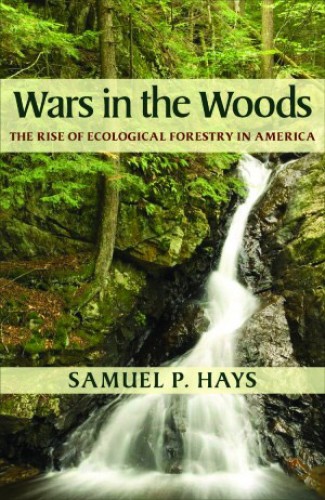by By Samuel P. Hays
University of Pittsburgh Press, 2006
My first reaction to the title of this book was to question how a distinguished scholar of conservation history could link “war” with an examination of forestry in America. Sam Hays began his experience in forestry over 60 years ago and has been an eyewitness to the events he has chronicled in several important books, none with such a provocative title. By the end of chapter two, however, it is quite clear that his title choice was right on. Like a reporter embedded in Iraq, he vividly describes the war underway over management of the nation’s forests.
He characterizes the protagonists as “traditional, commodity forestry” versus “ecological forestry.” He carefully describes the concepts and words that define the sharp differences between these camps of old and new forestry, pointing out the divergent vocabulary of each approach. For example, commodity forestry, based in the applied science of silviculture, speaks of stands, board feet, poles, and saw timber, while ecological forestry talks of the forest in terms of habitats, biodiversity, and indicator species, to name just a few of many divergent terms defining the two warring camps.
Hays, however, sees the “war” as much more than just a disagreement over terminology or basic biological science. For the most radical of traditional forest advocates, whom he views as “on the fringe,” ecological forestry is not seen as a debate over legitimate alternatives for forest management but rather as “a threat to traditional American values.” Hays says that as these stanch traditionalists “focused their attacks on the messenger rather than the message” in recent decades, the positions of both sides hardened.
The reaction of the mainstream forest establishment, however, is credited by Hays as launching the “most determined and uncompromising resistance to ecological forestry.” Here he examines the traditional positions of The American Forest and Paper Association, The Society of American Foresters, The National Association of State Foresters, and the various forestry schools, all of which seem unresponsive to public opinion or emerging environmental science. In the final chapter, he concludes that mainstream forestry is “a profession that has become immobilized by its own self-created public isolation.”
Hays also analyzes the more complex position of the U.S. Forest Service, an organization that has tried to be more responsive to changing laws, science, and public opinion, but not without causing tensions between the supervisory line officers and staff, and between foresters and personnel from other professions in the agency. Later in the book, in a chapter titled “The Skirmishes Become a Full-Scale War,” he describes the battle over National Forest planning, policies, and management as a nationwide struggle between traditional commodity forestry and ecological forestry. He decries how the Bush administration “set out to reverse three decades of environmental forest management,” including the Endangered Species Act, The National Environmental Policy Act, and the Clinton National Forest roadless policy. This, Hays asserts, is threatening “the long-standing professional cohesion” of the U.S. Forest Service as the Bush policies intensify conflicting views on forest management within the agency.
In a series of brief case studies, Hays examines the “war” at local, state, and regional levels, with a more in-depth analysis of Pennsylvania. Here he cites the growing influence of grassroots reform organizations, not only relative to local issues but also in shaping national forest policy by their involvement in forest planning and management appeals on individual national forests.
Some in New England may find Hays’s historical perspective on forest policy conflicts overblown, based on our comparatively low-key regional experiences. But few serious readers will be able to ignore his carefully documented analysis. If he’s right, our Yankee tradition of working out differences in forestry without resorting to “war” may be subsumed into the gathering conflict that Hays sees sweeping America.


